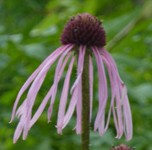 Pale purple coneflower is a herbaceous perennial native to the eastern half of the US where it grows in open areas on a variety of soils. It is a member of the aster family (Asteraceae) and has a raised center of coppery-orange disc flowers surrounded by long thin drooping ray flowers one to three inches long. The flower heads are up to three inches across and are carried on unbranched stems over a long bloom time in early to mid-summer. They are fragrant and attractive to butterflies. The dark green narrow leaves are four to ten inches long and have parallel veins. Plants self-seed. Since pale purple coneflower is tolerant of heat, humidity, drought, and poor soil it is a good choice for difficult sunny sites.
Pale purple coneflower is a herbaceous perennial native to the eastern half of the US where it grows in open areas on a variety of soils. It is a member of the aster family (Asteraceae) and has a raised center of coppery-orange disc flowers surrounded by long thin drooping ray flowers one to three inches long. The flower heads are up to three inches across and are carried on unbranched stems over a long bloom time in early to mid-summer. They are fragrant and attractive to butterflies. The dark green narrow leaves are four to ten inches long and have parallel veins. Plants self-seed. Since pale purple coneflower is tolerant of heat, humidity, drought, and poor soil it is a good choice for difficult sunny sites.
Type: Herbaceous perennial
Bloom: Daisy-like flower with a raised center of coppery-orange disc flowers surrounded by pale purple reflexed ray flowers one to three inches long, in early to mid summer
Size: 2-3’ H x 1-1.5” W
Light: Full sun but tolerates some shade
Soil: Average, dry to medium moist, well-drained, but tolerates much less
Hardiness: Zones 3-10
Care: Divide every four years
Pests and Diseases: None of significance
Propagation: Seed, division
Companion plants: Black-eyed Susan (Rudbeckia), gayfeather (Liatris spicata), Culver’s root (Veronicastrum virginicum), grasses